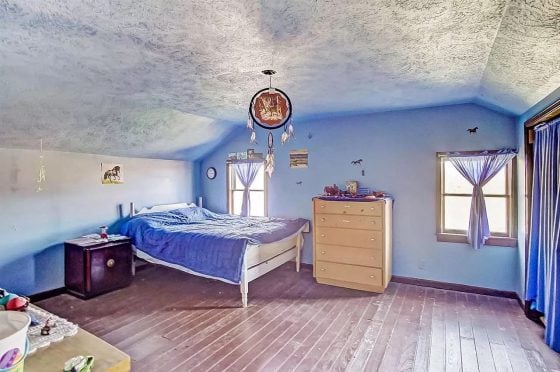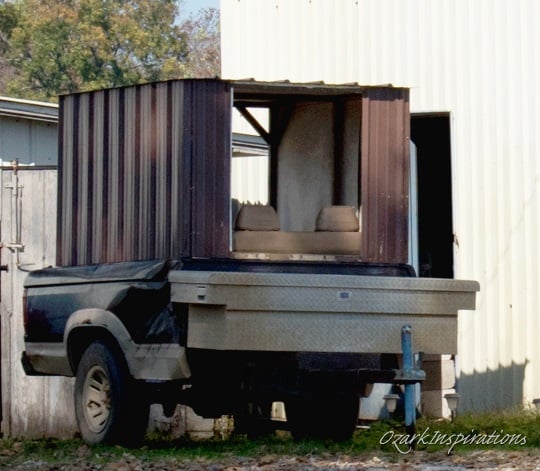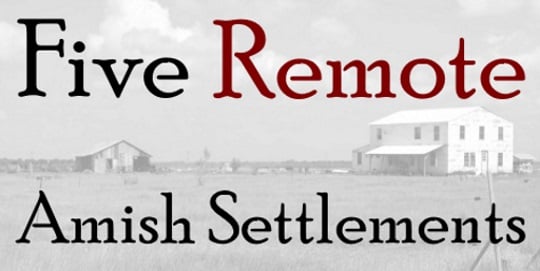5 (Mid-Decade) Amish Population Facts That Might Surprise You
Where have the Amish been settling lately? How rapidly are they growing? Where are the Amish “hot spots” on the map?
Over the past half-decade or so, the Amish have boosted their presence on the US (and world) map by adding communities in new, often never-before-settled places.
These include four new states (Vermont, South Dakota, Wyoming and Idaho), a pair of Canadian provinces (New Brunswick and Prince Edward Island), and even two South American countries (Argentina and Bolivia).

Thanks to a high birth rate and high retention, the Amish population is constantly growing. This leads to existing settlements getting denser, and inevitably, Amish in search of sparser pastures forming new ones.
On that note, I recently dipped back into an article in the Autumn 2015 Journal of Amish and Plain Anabaptist Studies (“A Mid-Decade Update on Amish Settlement Growth” by Joseph F. Donnermeyer & Cory Anderson).
In this article, the authors look at places where the Amish are growing both regionally, and on a state/province level.
They note that “new settlement growth has been most pronounced in states bordering historic regions of Amish settlement.” They reference an Amish population doubling time of 20.5 years, similar to that seen in these Young Center figures. They break down Amish population figures by US Census Bureau region. You’ll also find some neat regional settlement maps (in addition to the density map, partially pictured above).
From the article, here are 5 interesting points on the Amish population, and where it may be headed:
- Roughly half of the Amish settlements in existence (exactly 500 communities as of December 2015), have been founded since 2000
- Only 18 of the 500+ settlements were founded pre-1900. As would be expected, these tend to be the largest Amish locations, places like Geauga County, OH, Lancaster County, PA, and Nappanee, IN – though a few are small (5-church district Somerset County, PA, 3-district Yoder, KS, or Oakland, MD, at 167 years old but a single church district in size)
- No Amish settlements created during the Great Depression years of the 1930s are still around. The authors also note a dip in new settlements during the peak “Great Recession” years of 2008-9
- New York state has been a noteworthy Amish expansion zone, with 52 settlements – 37 of which were founded since the turn of the century. The Empire State could soon have more distinct settlement locations (but not population) than either Pennsylvania or Ohio
- Finally – and this is more about prediction – the authors suggest their 2013 forecast of 561 Amish settlements by decade’s end may in fact be too low
Seven million Amish by 2100 still seems like a stretch, but given current trends, who knows.







Michigan
My friend in Wisconsin says they’re considering moving to Michigan where several members of their community have gone. She’s originally from Indiana. It’s interesting and a little surprising to see how much movement there is among the Amish. She did say the older, more established members of the community disapprove of the ones leaving, seemingly for no reason other than the idea that any change is necessarily bad. It actually reminds me of rural English folk who cluck their tongues at the younger generations who look to move to areas with more opportunities for themselves, assuming they think they’re “too good” for the town they grew up in, even though it’s not about that at all for the young people. It’s funny because that’s exactly what I faced a couple months ago when I announced my decision to move to another state. I guess those attitudes are pretty universal across cultures.
Interesting observation Jan. Yes I don’t know the situation with the community you mention but the Amish move for different reasons, sometimes economic, sometimes to find a smaller, less crowded community, sometimes because they have concerns over the youth behavior (more common in larger communities). Some would be more sensitive to the pace of change than others, and moving to a more conservative community could be a solution in that case. It would be hard to leave family behind but if the perceived threat/benefit is great enough, it can be enough to motivate a move.
Plain ol’ land prices are often the reason. At $20,000/acre in the Holmes County main settlement area, young folks are keen to look beyond the township they grew up in for cheaper land.
How Long Can This Go On?
Demographers and ecologists are justified in looking at the Amish doubling rate with horror. The Human global ecological footprint is now on the order of 1.5 Earths-worth of ecosystem services per year, which services are actually depleting while the population continues increasing. We’re draining our God-given global resource bank account. We have already overshot Earth’s human carrying capacity by half and are extinguishing species, soil fertility, groundwater, and mineral resources, our primary sources of material well-being, far faster than they can be replaced.
Yet, I would argue, that a growing influence of Amish culture might be the best thing that has happened to the human species, if they decide to get their reproduction in balance with our limited supply of God-given resources. God gave us a finite world. He expects us to husband it, to manage it sustainably, not to consume it as fast as humanly possible. Unlimited growth is not in the cards for anyone or anything. Humans are no exception. Still, I argue, with the exception of their attitude toward reproduction, the Amish culture may be precisely what is needed to save the world for generations of humans to come.
The human species is the most materially successful creature ever to have existed. In this case, material success is defined as control over one’s life circumstances, most particularly natural resources. This has been accomplished primarily through social communities that practice cooperation, sharing, caring, loving, and forgiving one another. It has also required us to control our reproduction so we don’t greedily abuse our resources, which, it should be obvious, is one of the most important ways we abuse one another. Greedily abusing community resources counters all the good that our social communities can do. The overwhelming majority of the spread of Amish communities is the result of running short of local resources. Eventually there won’t be anywhere else to go.
If the human species could work toward becoming a single global community, caring, sharing, cooperating, helping, and forgiving, which are Amish values to the core, we would only need to take care we don’t over-reproduce and don’t over-use our God-given resources. That is a world that would be much more uplifting and nurturing to live and worship in.
European nations and Japan are aging out and not reproducing themselves and the US is on the same trajectory. Abortion has claimed the lives of one billion children in the past 100 years. I hardly think we are in danger of depleting resources. We are in danger of losing whole populations. Yes we should be stewards of this earth but we should also be raising families which too many people are not. I don’t think the Amish are a threat to over population. We could learn from their love of children and community.
Don't worry ...
We are a long ways from using up our resources. The US government has paid farmers for many decades not to plant some of their ground. In both Ohio and Pennsylvania, unused farming land is being grown up and turning back into woodlands because profitability is too low. I can show you aerial photos from the early 1900s to prove that. Ohio was only 10% wooded in 1900, now it is somewhere between 30% and 40% wooded.
Having lived in South America, I saw the exact same thing happening: land being abandoned because of low profitability, with people hording into cities to find a good-paying job.
The main thing that hinders everyone on earth from having plenty of food and shelter is a word that starts with a “P” … politics, along with plain old self-centeredness.
I would personally believe the world could easily support a 10X greater population if we would all love one another.
Now, to do my little part …
Taking Care of God's Bounty
The global human population is presently at 7.3 billion. Population experts are projecting about 10 billion by 2050. If that rate of increase holds through 2100, global population will be about 16 billion. But, the U.S. is growing rapidly as well. If the current U.S. rate of growth were experienced world-wide through year 2100, the world would still have over 12 billion people. If the world grew as fast as the Amish population, the population would be over 120 billion people by 2100!
The world doesn’t have resources for 12 billion people, let alone 16 billion – or 120 billion. The most optimistic credible long-term global human carrying capacity is no more than 4 billion. Half of the world’s wildlife has disappeared in the last 40 years and the rate of loss is increasing rather than decreasing. Species extinctions are now on the order of 1,000 times the natural historic rate, and this includes critical pollinators. The world’s soils have lost around 2/3 of their organic matter, the stuff that makes soils naturally fertile and productive, in the last 200 years and that loss is increasing. The artificial petrochemicals we pump into soils to make up for the deficit will soon be scarce and/or prohibitively expensive. 63 of 89 industrial mineral resources were determined to be scarce in 2008, which means the price is only going to rise. Water reserves in 21 of the world’s 37 largest aquifers have declined since 2003, meaning we are using ground water faster than it is being replenished and it will eventually run out. With no reduction in greenhouse gas emissions, global temperature by 2100 could be as much as 30 degrees Fahrenheit warmer than today. A typical summer day of 120 degrees would not be survivable for most of us. It would be absolutely lethal for crops and livestock.
God has already provided. Now, it’s up to us to take care of it. We can’t continue to grow our numbers when the numbers we already have are destroying the bounty He has provided.
I agree 100% that we are called to wisely manage our resources. But I don’t agree with the doomsday people that say we are about to run out of resources. Currently the US farms and grazes something close to 1 billion acres of land. Under close cultivation and tender care, only 1/3 to 1/2 an acre can feed one person, and some people say even less than that. So that means the US alone could provide food for 2-3 billion people, by itself. And that does not include the millions of acres that could be utilized (such as the median strips in between and along the edges of Interstate highways, and the millions of acres that are not being cultivated but could be).
Within a couple miles circle of our house here in Coshocton County, Ohio, are hundreds of acres (likely a thousand or even two, havent counted it all) that are just being mowed off every year and used for deer hunting. Killing 25 bucks a year off of a few thousand acres of land is hardly considered using the land for all its potential.
🙂
The Legacy of Oil
Over half of the world’s agricultural production today is a product of petrochemicals. As oil and natural gas become more expensive and difficult to produce, that production will drop while food prices rise. World agricultural production has plateaued in the last few years. Nobody knows how to increase food production on a global scale without these artificial inputs and they are becoming more costly and difficult to provide.
If you can look at the world objectively, relying on real numbers, and remain optimistic, I envy you. I can’t. I am absolutely convinced we need to put the brakes on population and consumption. The Amish are admirably showing the way on consumption. Now they need to embrace the logic of a sustainable population size and teach the rest of the world.
The very fact that Amish young people are having to leave their homes and find new ones because of lack of land or lack of jobs, and the fact that new land is increasingly unaffordable, should suggest that something is out of whack and that it can’t continue this way forever.
Don Wilkin
……..TAKE “MONEY” AND “RELIGION” OUT OF THE EQUATION AND THE WORLD WILL BE GREAT AS THE ALMIGHTY WANT IT TO BE !
Does anyone know the Number of Old Order Amish, Old Order Mennonite, Mennonite (etc) Farms in America – Canada. The USDA doesn’t seem to know . Many Thanks PJ
Does anyone know where in New Brunswick the new settlement is? All I’ve been able to find online is a couple of mentions of the Maine settlement of Fort Fairfield expanding across the border, but I’m not sure if that would be counted as a settlement within New Brunswick or not.
Amish in New Brunswick
RC, I haven’t been able to find mention of Amish beyond this area across the border from Fort Fairfield, ME. The link below names a community in the area of Carlingford, which would be across the border from Fort Fairfield.
I assume this is the New Brunswick presence, though if someone knows otherwise, would be glad to hear about it. The information at this link discusses that presence briefly: http://www.pahome.ca/The%20Hist.%20of%20Carl.%20All%20on%20one%20WORD%20Doc..pdf
“There are currently 3 Amish families establishing their roots
in Carlingford. They have re-located from communities in Ontario.
These 3 families include 29 children.
The Amish have purchased land to farm and are currently building
their homes and barns etc.”
There are a few families in the Woodstock area of New Brunswick.